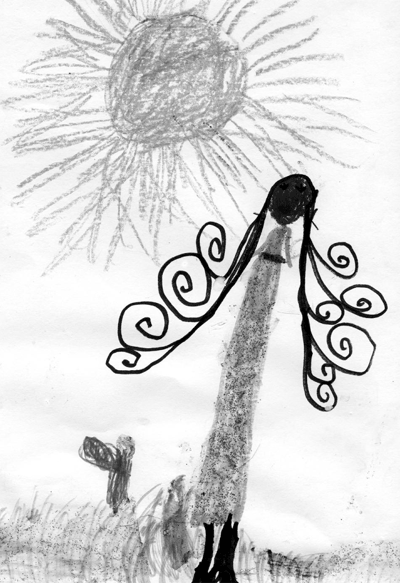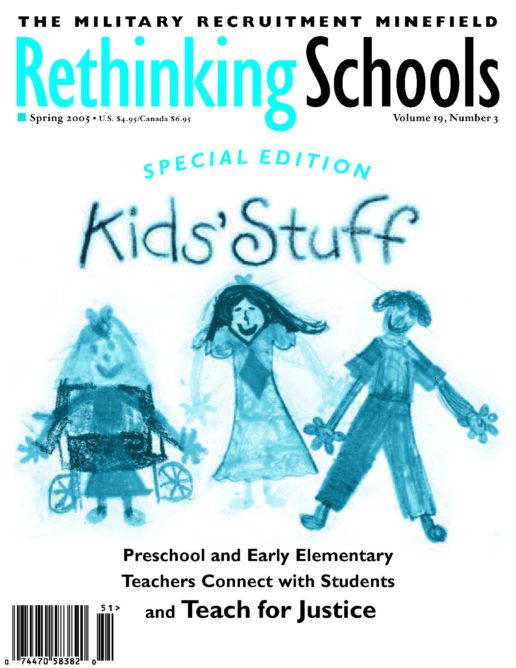Welcoming Kalenna
An early childhood teacher strives to make all her students feel at home
Illustrator: Ethel Jeanne Aliénor Renia

When I was a child, our home was filled with the sounds of Spanish, mariachi music, and boisterous conversations. At home, my Nana cooked enchiladas, menudo, and tamales. During family celebrations we broke piñatas, danced, and hung papel picados. I was surrounded by six siblings, multiple cousins, tios, and tias. My home was filled with light, color, art, texture, and love.
My school, in contrast, was drab, white, and unappealing.
I recall only one time when my Mexican-American identity was validated during elementary school. When I was in third grade, my mother organized a Cinco de Mayo event at our school. My father, siblings, and I cut out the papel picados, made the piñatas, formed the paper mâché sculptures, and created paper flowers. Seeing my culture represented at school made me feel at home there for the first time.
I want my students to have more than one memory like that. I’ve taught preschool for 27 years, and I feel passionate about embracing families from non-dominant cultures into the early childhood communities I work in.
As the result of a personal process of identity and cultural reclamation, I came to understand how my personal experiences influence this passion.
My experiences inspired me to find ways to make other marginalized children and families see themselves and their lives reflected in our classroom community.
Welcoming Kalenna
One fall day a few years ago, I held an open house to welcome the new children and families enrolled in our preschool program. When Kalenna entered our classroom, I immediately felt an affinity with her. Kalenna’s dark, thick hair and chocolate brown skin set her apart from most of the other 14 children in the class. Our community college lab school served predominantly European-American children whose parents were taking classes. Her mother, Diane, spoke with an accent that made me wonder if English was not her first language.
“Do you speak a language in addition to English?” I asked Diane.
She smiled and answered, “Marsh-allese.” Our journey had begun.
I sensed Diane’s feeling of relief and surprise when I asked about her language history. I knew from my own experiences what it was like to not be seen, to be treated with a question mark. I wondered how many times others had asked her, as they had me, “what she was” rather than respectfully and authentically inquiring about her. My question was an open and honest acknowledgement of her differences.
Over the next few months, I tried to infuse our classroom environment with the sounds, textures, and objects that surrounded Kalenna in her home.
First I had to learn about the Marshall Islands. I had no idea where or what the Marshall Islands were, let alone anything about the Marshallese language and culture. I started with a map, where I learned that the Marshall Islands are a collection of 1,225 islands and islets in Micronesia. From the Internet, I learned about the ongoing struggle of the Marshallese people to maintain their language and culture given their history of domination by Germany, Japan, and the United States. Following World War II, the United States conducted nuclear tests on the islands—including Bikini Atoll. These tests exposed many inhabitants to high radiation levels.
After gaining some knowledge of her origins, I was able to begin to speak more confidently with Kalenna’s family. I began regular conversations with Diane, each of us sharing information about our family and culture.
I discovered a website with Marsh-allese music and language. I printed a list of simple words and phrases and brought it to the classroom. I showed Diane what I had found and asked her to translate a song into Marshallese. Each morning the children, student teachers, and I sang a greeting song utilizing the home languages of the children and adults present in our classroom, including Spanish, Chinese, and Afrikaans. Diane taught us how to sing our good morning song in Marshallese.
I asked Diane if she could help me locate items from the Marshall Islands that the students might use in the classroom. She brought in a hat, a basket, clothing, a hairpiece, and a necklace. We incorporated them into our dramatic play area. The children frequently wore the hairpieces and hat. The large basket with shells held an assortment of classroom materials throughout the year. The children loved wearing the seashell necklaces. They knew that the items belonged to Kalenna and treated them with care and respect.
I invited Diane to record the book No, David, by David Solomon, on audiotape in Marshallese. The book was a favorite in our classroom due in part to the artwork, the simple text, and message of unconditional love. In the story, a little boy repeatedly gets in trouble for typical misbehaviors, including making a mess, overfilling the bathtub, and playing with a baseball in the house. The story concludes with the mother expressing her enduring love for him despite his antics. The children already could “read” each page in English. I partnered Diane with a mom who spoke Spanish. Together they recorded the book in their home languages. The mothers joined us at circle time to read the book aloud and to allow us to hear their voices on tape. From then on, Kalenna listened frequently to her mother’s voice reading Jaab, David.
Bridging Cultures
One of my best memories of Kalenna is of the day she brought some of “her music” to class. I had invited her mother to share music that they listened to at home, in part because I was having difficulty locating Marshallese music.
Kalenna and I went to the CD player and began to listen. At first we listened to it as background music while the students played. Later Kalenna went to the large rug area. I began to move to the music and told her how much I liked it. Then she began to dance. As she danced, a magnificent smile appeared on her face. She clearly had a specific routine that she’d learned for that particular song. I began to mimic her movements. When the song ended, I rewound the tape and started it again. She began to teach me the moves. We laughed and moved, reveling in our intimate shared enjoyment. The other children watched, pausing in their own play to see our scene unfold. Later, some came and joined us. Kalenna’s delight was evident as our dance continued. I had finally touched her where she lived.
A few years ago a former teacher of mine told me that he always pictured my face while reading of a young Mexican woman in the novel The Pearl. I was shocked. I never knew that he saw me as Mexican, that he associated me with the language, the culture, and the stories. I was touched, yet felt a loss. The loss was about not having my identity validated some 25 years earlier.
How I yearned to have a teacher who could see me, hear me, and dance with me.

